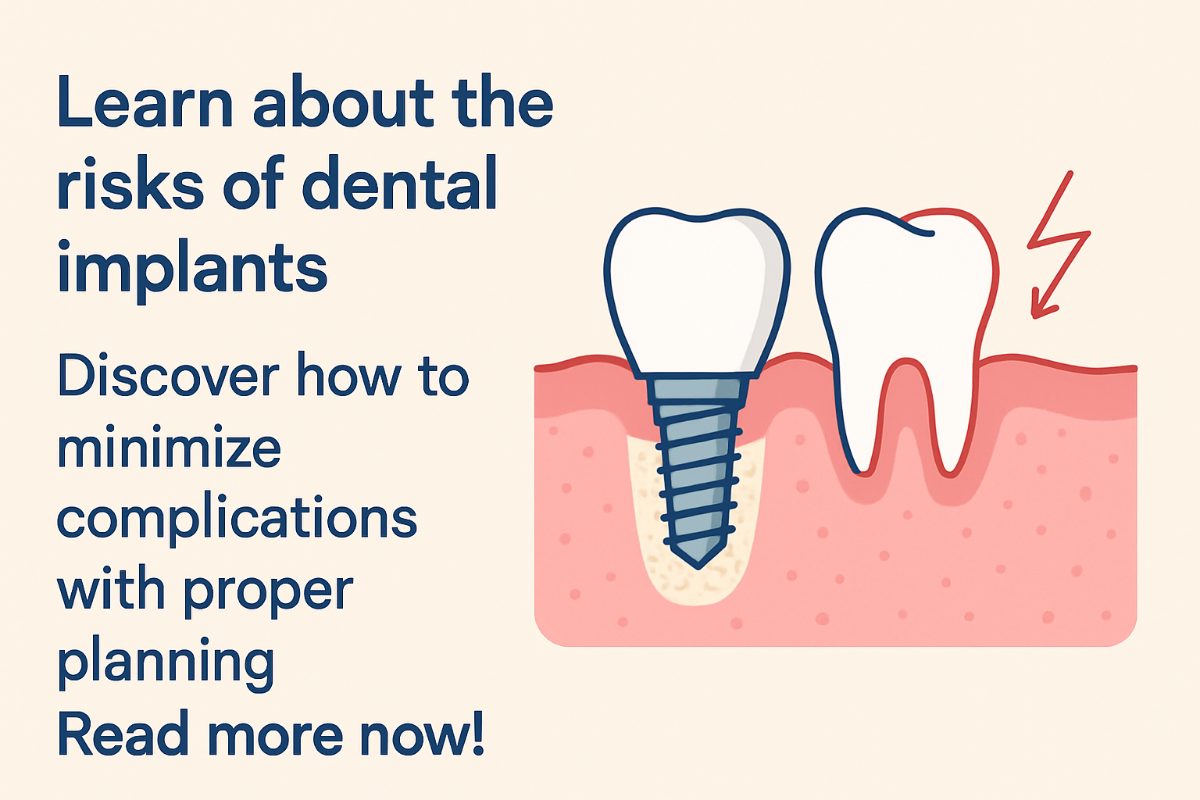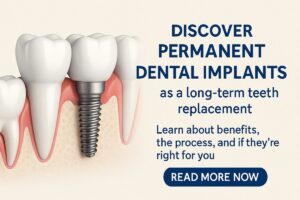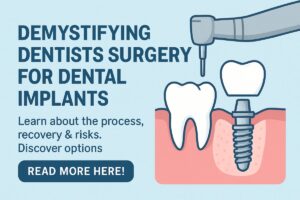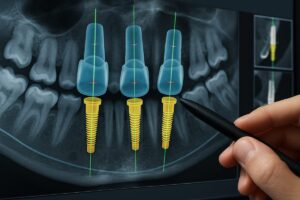Dental implants are a common and usually successful way to replace missing teeth. Still, it’s important to understand the risks of dental implants before you decide. Knowing the possible complications helps you ask the right questions, prepare better, and choose the best care.
This guide explains the main risks, how likely they are, what your provider can do to lower risk, options for people told they have no bone, and when to call for help. It ends with practical next steps if you’re considering implants.
Common risks of dental implants
- Infection at the implant site: Bacteria can cause redness, swelling, pain, or pus. Left untreated it can lead to implant loss.
- Implant failure or loosening: Early failure happens when the implant doesn’t integrate with bone. Late failure can occur from overload, infection, or bone loss.
- Nerve injury: Damage to nearby nerves can cause numbness, tingling, or pain in the lip, chin, or tongue. It can be temporary or, rarely, permanent.
- Sinus complications: Upper implants placed too close to the sinus can cause sinus infections or a perforation of the sinus lining.
- Peri-implantitis and long-term bone loss: Inflammation around the implant can destroy bone over time and lead to implant failure.
How likely are these risks?
Overall success rates for dental implants are high — commonly around 95% or more for healthy patients over several years. Still, risk varies by patient and treatment choices.
- Higher risk if you smoke, have uncontrolled diabetes, poor oral hygiene, or poor bone quality.
- Previous radiation to the head and neck increases risk.
- Complex cases (lack of bone, grafts, or sinus work) carry higher chances of complications.
Understanding your personal risk helps set realistic expectations about the risks of dental implants and long-term outlook.
How planning and technique lower the risks of dental implants
Pre-op evaluation
A full medical and dental history plus 3D imaging (CT or CBCT) finds red flags before surgery. Scans show bone amount, nerve position, and sinus size so your surgeon can plan safely.
Surgical technique and technology
Digital planning, guided surgery, and precise implant placement reduce the chances of hitting a nerve or entering the sinus. Using guides and computer planning improves accuracy and healing.
Strong planning and modern technique are key to avoiding many of the common complications and improving long-term success.
Special cases: patients told they have no bone
Being told you have “no bone” is not always the end of the line. Options include bone grafting or using specific implant approaches that avoid deficient bone. These include:
- Zygomatic implants (anchored in the cheekbone)
- Pterygoid implants (anchored behind the upper jaw)
- Transsinus techniques
- Subperiosteal implants (placed on top of bone under the gum)
These approaches have unique risks and require a specialist with experience in advanced implant surgery. Specialist care reduces complication rates in complex cases.
Recovery, warning signs, and when to call your provider
Normal healing: mild to moderate pain, swelling, and bruising for a few days. Most people return to normal activities in a week or two. Antibiotics and pain control are common early treatments.
Watch for these red flags and call your provider right away:
- Fever or increasing redness and swelling
- Worsening pain after the first few days
- Persistent or worsening numbness or tingling
- Loose or moving implant
- Foul taste or pus from the site
If you have severe bleeding, difficulty breathing, or spreading infection, seek emergency care immediately.
Choosing a provider to reduce the risks of dental implants
To lower your chances of complications, ask potential providers about:
- Board certification and specialty training
- Experience with complex cases and alternative implant techniques
- Use of CT/CBCT imaging and digital workflows
- Success rates and how they handle complications
Dr Michael Fioritto is one of about nine board‑certified implant specialists in Ohio. He offers advanced options for patients told they have no bone, uses facial, intraoral, and photogrammetry scanners, and runs a digital workflow for All‑on‑X cases. He also teaches local dentists and accepts many out‑of‑state patients who meet him just before surgery. Free consultations and CT scans are available.
Conclusion and next steps
Dental implants are a reliable solution for many people, but the risks of dental implants are real and vary by patient and procedure. Learn your personal risk factors, insist on proper imaging and planning, and choose a provider with the right training and experience.
If you’re considering implants, schedule a consultation and CT scan to get a clear treatment plan and realistic risk estimate. Ask specific questions about outcomes and how complications are handled before you move forward.






